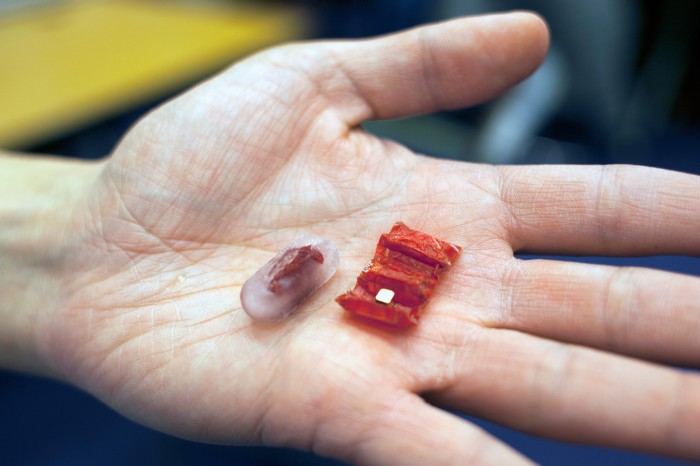In experiments involving a simulation of the human esophagus and stomach, researchers at MIT, the University of Sheffield, and the Tokyo Institute of Technology have demonstrated a tiny origami robot that can unfold itself from a swallowed capsule and crawl along the stomach wall to patch a wound or remove a swallowed button battery. Every year, 3,500 swallowed button batteries are reported in the U.S. alone. The batteries can cause a chemical reaction that can lead to disfigurement and even death.
The robot propels itself chiefly through a “stick-slip” motion, in which its appendages stick to a surface through friction when it executes a move but slip free when its body flexes to change its weight distribution. It can also push against fluid like an oar.
The robot is rectangular, with accordion folds perpendicular to its long axis and pinched corners that act as points of traction. In the center of one fold is a permanent magnet that responds to changing external magnetic fields, which control the robot’s motion.

In their search for biocompatible materials to serve as the robot’s structural layers, the researchers “spent a lot of time at Asian markets and the Chinatown market,” says Shuguang Li, a postdoc in Professor Daniela Rus’s research group, which led the new work. They finally settled on the type of dried pig intestine used in sausage casings.
The researchers’ test bed is an open cross-section of the stomach and esophagus, molded from a silicone rubber with the sponginess and flexibility of a pig’s stomach. A mixture of water and lemon juice simulates the stomach fluids.
Keep Reading
Most Popular
Large language models can do jaw-dropping things. But nobody knows exactly why.
And that's a problem. Figuring it out is one of the biggest scientific puzzles of our time and a crucial step towards controlling more powerful future models.
The problem with plug-in hybrids? Their drivers.
Plug-in hybrids are often sold as a transition to EVs, but new data from Europe shows we’re still underestimating the emissions they produce.
Google DeepMind’s new generative model makes Super Mario–like games from scratch
Genie learns how to control games by watching hours and hours of video. It could help train next-gen robots too.
How scientists traced a mysterious covid case back to six toilets
When wastewater surveillance turns into a hunt for a single infected individual, the ethics get tricky.
Stay connected
Get the latest updates from
MIT Technology Review
Discover special offers, top stories, upcoming events, and more.